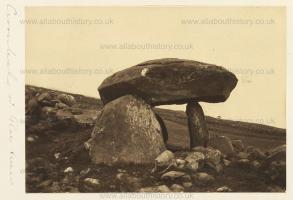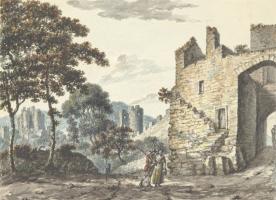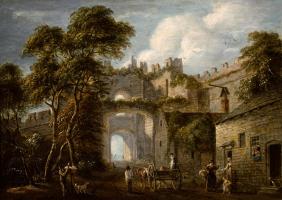Text this colour links to Pages. Text this colour links to Family Trees. Text this colour are links that are disabled for Guests.
Place the mouse over images to see a larger image. Click on paintings to see the painter's Biography Page. Mouse over links for a preview. Move the mouse off the painting or link to close the popup.
All About History Books
The Chronicle of Abbot Ralph of Coggeshall describes the reigns of Kings Henry II, Richard I, John and Henry III, providing a wealth of information about their lives and the events of the time. Ralph's work is detailed, comprehensive and objective. We have augmented Ralph's text with extracts from other contemporary chroniclers to enrich the reader's experience. Available at Amazon in eBook and Paperback.
Conwy is in Carnarfonshire.
On 22nd March 1582 Archbishop John Williams was born to Edmund Williams in Conwy [Map].
In May 1645 John Owen (age 45) forcibly took Conwy [Map] whose defences had been arranged by the native Archbishop John Williams (age 63).
On 19th February 1650 Richard Bulkeley was killed in a duel with Thomas Cheadle, or was murdered by Thomas Cheadle, on Lavan Sands, Menai Straits [Map] on for which the latter executed at Conwy [Map].
Colonel John Whitley was killed at the defence of Conwy [Map].
The Itinerary of Archbishop Baldwin through Wales: Book 2 Chapter 10. Having crossed the river Conwy,162 or rather an arm of the sea, under Deganwy [Map], leaving the Cistercian monastery of Conwy [Map]163 on the western bank of the river to our right hand, we arrived at Ruthlan [Map], a noble castle on the river Cloyd, belonging to David, the eldest son of Owen164 where, at the earnest invitation of David himself, we were handsomely entertained that night.
Note 162. The travellers pursuing their journey along the sea coast, crossed the aestuary of the river Conway under Deganwy, a fortress of very remote antiquity.
Note 163. At this period the Cistercian monastery of Conway was in its infancy, for its foundation has been attributed to Llewelyn ap Iorwerth, in the year 1185, (only three years previous to Baldwin's visitation,) who endowed it with very extensive possessions and singular privileges. Like Stratflur, this abbey was the repository of the national records, and the mausoleum of many of its princes.
Note 164. [David was the illegitimate son of Owen Gwynedd, and had dispossessed his brother, Iorwerth Drwyndwn.]
Chronicle of the Princes of Wales. 1230. One thousand two hundred and thirty was the year of Christ, when king Henry, having with him a vast armed host, sailed for France, with the intention of obtaining his right as to Normandy and Anjou and Poictou. And soon after that, on account of a storm and mortality, being disappointed of his purpose, he returned to England. That year, William Canton of Cemaes died. Then young Llywelyn, son of Maelgwn, died, on his estate in Gwynedd, and was honourably buried at Aberconway [Map].
After 25th February 1246 Dafydd ap Llewellyn Aberffraw Prince of Wales (deceased) was buried at Aberconwy Abbey [Map].
In 1248 Gruffydd ap Llewellyn Aberffraw was buried at Aberconwy Abbey [Map].
Deganwy Castle is also in Castles in Carnarfonshire.
The Itinerary of Archbishop Baldwin through Wales: Book 2 Chapter 10. Having crossed the river Conwy,162 or rather an arm of the sea, under Deganwy [Map], leaving the Cistercian monastery of Conwy [Map]163 on the western bank of the river to our right hand, we arrived at Ruthlan [Map], a noble castle on the river Cloyd, belonging to David, the eldest son of Owen164 where, at the earnest invitation of David himself, we were handsomely entertained that night.
Note 162. The travellers pursuing their journey along the sea coast, crossed the aestuary of the river Conway under Deganwy, a fortress of very remote antiquity.
Note 163. At this period the Cistercian monastery of Conway was in its infancy, for its foundation has been attributed to Llewelyn ap Iorwerth, in the year 1185, (only three years previous to Baldwin's visitation,) who endowed it with very extensive possessions and singular privileges. Like Stratflur, this abbey was the repository of the national records, and the mausoleum of many of its princes.
Note 164. [David was the illegitimate son of Owen Gwynedd, and had dispossessed his brother, Iorwerth Drwyndwn.]
On 19th June 1790 John Gibson was born at Gyffin. He moved with his family to Liverpool aged nine.
In 1246 Ednyfed "Fychan aka Younger" Tudor (age 76) died. He was buried at Llandrillo yn Rhos Church.
Maen y bardd Burial Chamber is also in Prehistoric Wales Neolithic Burials.

August 1896. Godfrey Bingley (age 54). Maen y bardd Burial Chamber [Map].

1795. John Ingleby (age 46). Upper Gate, Conway [Map].

Before 1809. Paul Sandby (age 77). 'South Gate Conway Castle. & Town'. Appears to be the south side of the Upper Gate, Conway [Map].

Before 1809. Paul Sandby (age 77). "Upper Gate, Conway [Map]".